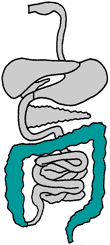 large intestine
large intestine
 I ' m s u r e y o u ' v e
I ' m s u r e y o u ' v e
s e e n a p i c t u r e
o f a l a r g e
i n t e s t i n e b e f o r e !
l a r g e i n t e s t i n e
![]() The large intestine is made up of four parts: the colon, cecum, appendix,
and rectum. Material in the large intestine is mostly indigestible
residue and liquid. The large intestine has four basic functions:
1.) the reabsorbtion of water, 2.) the reabsorbtion of
electrolytes, 3.) the formation of feces, and 4.) the
storage of feces. If compared to the small intestine, it plays a very
little part in the digestive process.
The large intestine is made up of four parts: the colon, cecum, appendix,
and rectum. Material in the large intestine is mostly indigestible
residue and liquid. The large intestine has four basic functions:
1.) the reabsorbtion of water, 2.) the reabsorbtion of
electrolytes, 3.) the formation of feces, and 4.) the
storage of feces. If compared to the small intestine, it plays a very
little part in the digestive process.

![]() The large intestine secretes alkaline mucus that protects epithelial
tissues and neutralizes acids produced by bacterial metabolism. In
addition, the mucus aids in the holding together of fecal matter. Water,
salts, and vitamins are absorbed, and the remaining materials in the
lumen form feces, which are mostly cellulose, bacteria, and bilirubin.
The large intestine secretes alkaline mucus that protects epithelial
tissues and neutralizes acids produced by bacterial metabolism. In
addition, the mucus aids in the holding together of fecal matter. Water,
salts, and vitamins are absorbed, and the remaining materials in the
lumen form feces, which are mostly cellulose, bacteria, and bilirubin.
![]() Bacteria live and actively divide within the large intestine where they
play a large role in the processing of undigested material into feces.
When bacterial fermentation occurs, gas is produced within the colon at
the rate of about 500 milliliters per day. This rate increases greatly
after the consumption of beans or other vegetable material because the
passing of undigested plant matter into the large intestine renders
material for fermentation.
Bacteria live and actively divide within the large intestine where they
play a large role in the processing of undigested material into feces.
When bacterial fermentation occurs, gas is produced within the colon at
the rate of about 500 milliliters per day. This rate increases greatly
after the consumption of beans or other vegetable material because the
passing of undigested plant matter into the large intestine renders
material for fermentation.
l a r g e i n t e s t i n e q u i z
![]() Test your knowledge on the large intestine. Click on next to start the quiz, or move
on to the next section to skip the quiz.
Test your knowledge on the large intestine. Click on next to start the quiz, or move
on to the next section to skip the quiz.
The appendix is located near the large intestine. Appendicities results from the swelling
due to inflamation. This causes bacteria to grow. This becomes dangerous if the appendix
bursts, causing bacteria to spread.
back to top